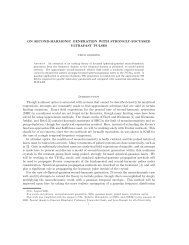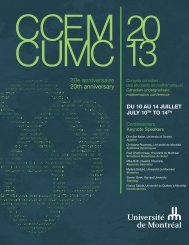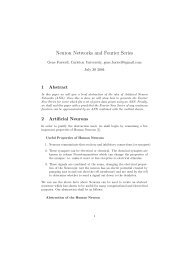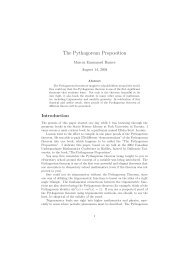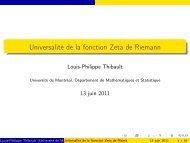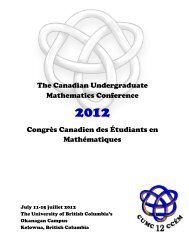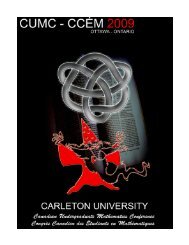booklet - CUMC - Canadian Mathematical Society
booklet - CUMC - Canadian Mathematical Society
booklet - CUMC - Canadian Mathematical Society
You also want an ePaper? Increase the reach of your titles
YUMPU automatically turns print PDFs into web optimized ePapers that Google loves.
INTRODUCTION MATHÉMATIQUE À LATEXELANA HASHMANEst-ce que tu t’es déjà demandé pourquoi les devoirs et les présentations de tescollègues ont une étrange ressemblance et paraissent si bien? Ils utilisent probablementL A TEX, un langage de balisage conçue pour la composition de documents avantl’existence de programmes comme Microsoft Word. Cette présentation a pour but demontrer comment utilisée L A TEXen tant que mathématiciens. Il y aura quelques preuvesélémentaires au travers et je vais aussi fournir d’autres outils et du code réutilisable.Même si la présentation est orientée vers les débutants, je vais m’assurer d’inclurequelques conseils pour les experts en TEX.DESCRIBING SYMMETRIES ( AN INTRODUCTION TO LIE GROUPS AND REPRESEN-TATION THEORY)ELLIOT CHEUNGGroups, are abstractions of symmetries, or "symmetry transformations" – and so,appear in nature as such. As a set of transformations, a particular finite group G isrelatively easy to describe – since we can just exhaustively enumerate all of G. Whathappens when G is an infinite set? This leads us to 2 classes of infinite groups forwhich a description of the group is more manageable. The first class, which will onlybe mentioned in passing, is the class of topological groups. Then, we will see how in thecase of the second class, that of Lie groups, a "linearization" of the group gives an approximatedescription of such groups. This is the process of assigning a certain vectorspace to a particular Lie group, and it may be called the Lie group - Lie Algebra correspondence.The above ideas will provide motivation for the idea of a representation ofa Lie group, and a description of the representations of SO(3)/SU(2) will illustrate thisLie Group - Lie algebra correspondence.Required Background: Inverse function theorem, basic topology, algebraFERMAT’S LAST THEOREMÉMILE GREERThis talk will cover the different attempts by mathematicians to solve Fermat’s LastTheorem. It will cover the different approaches in chronological order, giving due emphasisto mathematicians like Sophie Germain and Kummer. Finally, it will introducethe theory of modular forms and how that finally led to the proof by Andrew Wiles.VIRTUAL KNOTS AND BRAID THEORYEMILY DIESBraid theory is an area of topology studying braids as abstract geometric objects.The braid group, as introduced by Emil Artin, allows one to study braids purely interms of their algebraic properties. Braid theory is studied for its own sake, but is alsoused to approach many questions in knot theory.Virtual knot theory was introduced by Louis Kauffman in 1999 as a generalizationof classical knot theory. In the past decade, many interesting open problems in knot26



